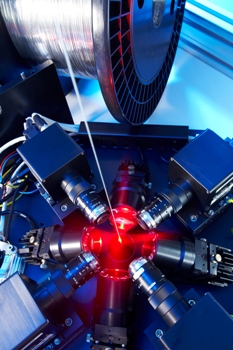Apr 3 2014
Pipes, rails, and wires are manufactured at high speeds. A new optical inspection system reviews the workpieces at 10 meters a second and finds defects in real time that can be as narrow as a single hair.
 With the WIRE-AOI wire inspection system, four cameras collectively deliver 40,000 analyzed images per second. Thus, a 100% control of the wire surface in real time can also work with very rapid production processes. © Fraunhofer IPM
With the WIRE-AOI wire inspection system, four cameras collectively deliver 40,000 analyzed images per second. Thus, a 100% control of the wire surface in real time can also work with very rapid production processes. © Fraunhofer IPM
The wire blank shoots from the drawing die which molds it into the desired shape. Up to ten meters per second, the workpiece is fast – and thus can keep pace with world-class runners like Usain Bolt. At these speeds, an in-line inspection – inspecting the workpiece during the production process – would have been inconceivable, until now. Researchers at the Fraunhofer Institute for Physical Measurement Techniques IPM in Freiburg have now closed this technological gap. Their optical inspection system, WIRE-AOI, can detect defects in strip products in real time. Strip products are long workpieces – like pipes, rails, wires, or boards – that are manufactured at high flow velocities. The inspection system detects micro-defects that zoom past it at ten meters per second, and are no thicker than a human hair. Workers then see the processed defects depicted graphically on a monitor, and can remove the corresponding pieces. The system marks the location of the defect, and stores the associated camera image in a database. This way, the makers of strip products can identify, classify, and document defects during production. For instance, by determining surface defects at the threshold levels for depth, width, and length adapted for their own production. If the workpiece exceeds these parameters, then the software sounds the alarm optically and acoustically.
10,000 images per second
Four high-speed cameras deliver the images of the defects. Each one is capable of shooting 10,000 images per second, and processing them in real time. “Only a handful of models for industrial camera inspection are able to record this number of images in the first place, much less analyze them in real time,” says Dr. Daniel Carl, group manager for Inline Measurement Techniques at IPM. Prerequisite for this peak performance are cellular neuronal networks. “That means each pixel is itself a computer in its own right. In order to program these, you need specialized knowledge about parallel architectures that the team at IPM has at its disposal.” The corresponding software must first enable the system to analyze the images shot by the camera.
An LED light developed by Carl’s research team puts sharpness into the camera images. Its light shines at a 5 millionth of a second, as bright as 100 suns, and flashes 10,000 times per second. “That is just like normal photographs. The brighter the light and shorter the illumination period, the sharper the images of moving objects. The image does not blur since, in such short periods of time, in principle nothing moves - even at speeds of up to 10 meters per second,” Carl added. The human eye can hardly perceive these very short light times. Therefore, the system is safe for the retina despite the extreme brightness.
Another important element: sturdy housing. Because things can get rough when producing strip products. For example, in the production of wire: The blanks are either rolled or drawn through dies. This can get messy, or the system vibrates. The inspection system, with its sensitive electronic and optical components, is in the middle of the production line. “The workpieces literally go directly through it,” describes Carl.
Minor defect, major impact
The drive to develop the sturdy, very fast and precise inspection system came from colleagues at the neighboring Fraunhofer Institute for Mechanics of Materials IWM. “Their job is materials inspection, including that of wires. We noticed that these could have many and very diverse defects if they were produced industrially, but that an inline inspection system would have missed until now,” says Carl, in whose group the first prototype was developed. Even the smallest surface defect – not larger than a few micrometers – could have undesired consequences: Either right in production, when the defective wires are processed further – and bring the machinery to a stop. Or as part of the end product, if they disrupt its function. One example is defective wire springs were installed in motorized valves, which could lead to damage to the motor.
The inspection process has matured to the point that the scientists are now offering it to wirepullers. The technology has already been successfully in use for some time now; several additional projects are planned. Anyone who would like to make an image themselves: The IPM researchers are exhibiting their superfast wire inspection at the wire trade show from April 7 to 11, 2014 in Düsseldorf (Hall EN/08), at Control from May 6 to 9, 2014 in Stuttgart (Hall 1, Booth 1502), and at the Wire Industry Convention May 8, 2014 in Iserlohn.